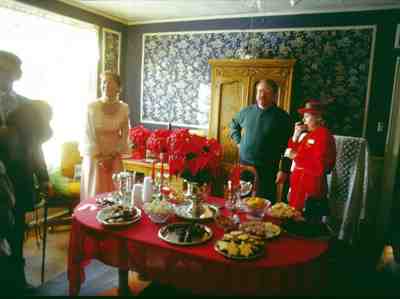Article by Lynda La Rocca
Event – December 2007 – Colorado Central Magazine
IT’S BEGINNING TO LOOK a lot like Christmas. And in Leadville, that means it’s time to deck the halls– and the doors, windows, mantelpieces, and sideboards– and celebrate the season at the 24th annual Victorian Days Weekend.

This journey back in time begins the evening of November 30th with caroling, a visit from Santa, the Parade of Lights, and the lighting of Leadville’s Christmas tree on downtown Harrison Avenue.
On Saturday, December 1st, the Victorian Home Tour showcases ten lavishly decorated residential, commercial, and civic establishments, including a frontier-era saloon and a century-old city building once policed by government “spies.”
The merriment continues that evening with cocktails and a sumptuous Christmas dinner before concluding on December 2ndd with an elegant holiday tea served at the 1886 Delaware Hotel.
The program of events also includes a night of casino and parlor games along with presentations on Victorian-era architecture, historic preservation, and Leadville’s famous– and infamous– ladies.
“During Victorian Days, we pull out all the stops,” says Heather Scanlon, Executive Director of the Leadville/Lake County Chamber of Commerce, the event’s sponsor. “It’s a real treat for anyone who wants to experience what a holiday weekend in the late 1800s might have been like.”
Indeed, this frontier-era silver-mining boomtown– North America’s highest incorporated city at 10,152 feet in elevation– is the perfect setting for an old-fashioned Christmas. Framed against a backdrop of glistening peaks, Leadville is steeped in Victoriana, from the brightly painted fa¸ades of its gingerbread houses to the gaslight-style streetlights illuminating its business district.
In honor of the season, homes, businesses, and even those streetlights are decorated with evergreen garlands accented by bright red bows. Candles glow from behind stained glass windows, throwing jewel-toned patterns onto freshly fallen snow. Tiny white lights twinkle from trees draped with cranberry chains, handmade dried-flower bouquets, and miniature gold-satin fans.
At each stop on the Victorian Home Tour, community members dressed in period costumes greet guests and serve as guides, pointing out striking design features and special holiday decorations, and relating colorful anecdotes about the structure’s origins and its 19th-century occupants. Music plays softly in the background as guests sample punch ladled from cut-glass bowls and hors d’oeuvres presented on silver platters. Expect to nibble on such delicacies as savory pâtés, crab-stuffed mushrooms, and homemade breads, tarts, cookies, and petit fours.
TO ENTER THESE establishments is to return to an era when the rough-and-tumble atmosphere of a frontier mining town was juxtaposed with such charming domestic touches as faux grain-painted woodwork, pressed tin ceilings, inlaid hardwood floors, elaborately trimmed window coverings, and claw-footed bathtubs.
The Bedford residence, a 126-year-old private home on this year’s tour, even has a “widow’s walk,” a tower with round bulls-eye windows capped by a French-style mansard roof. A common addition to homes in coastal communities, this tower’s ominous nickname refers to the vigils kept there by sailors’ wives, who anxiously scanned the storm-tossed horizon for an overdue ship. In landlocked Leadville, the tower may have provided a bird’s-eye view of a miner returning home safely from another shift in the perilous underground.
Other tour stops include the 1879 Silver Dollar Saloon with its original tile floor, intricately carved back bar, diamond-dust mirrors hauled from St. Louis by covered wagon, and collection of mounted wildlife that has enhanced the eclectic décor since the 1930s. There’s also the massive brick City Hall building, constructed from 1903-1905 to house federal offices and equipped with a series of secret passageways that enabled supervisors to “spy” on employees, a Big- Brother-like move designed to weed out thieves and slackers.
WHEN THE Tabor Opera House opened its doors on November 20, 1879, it was promptly dubbed “the finest playhouse west of the Mississippi.” This three-story, brick-and-stone structure was built in just 100 days for one of Leadville’s most notorious founders, the flamboyant and ultimately tragic silver-mining magnate H.A.W. Tabor. (Like other Leadville-made mining millionaires, including James Joseph Brown, husband of the “Unsinkable” Molly, Tabor’s mansion was located in Denver, the hub of high society.)
Considered the epitome of opulence with its gaslights, beveled glass, lace curtains, velvet-upholstered seats, and hand-painted backdrops, the 880-seat Tabor Opera House hosted performances by such luminaries as bandmaster and composer John Philip Sousa, magician Harry Houdini, and actress Helena Modjeska. Its audience could be equally impressive: President Ulysses S. Grant once watched a play there from a seat in Tabor’s private box.
When writer Oscar Wilde gave a talk on “the practical application of the æsthetic theory to exterior and interior house decoration,” bored opera-house stagehands unexpectedly dropped the heavy curtains, tumbling the outlandishly dressed dandy headfirst into the orchestra area. Wilde subsequently dispelled this unfortunate first impression by drinking the locals under the table and descending into the Wolftone Mine in an ore bucket, where he was honored at a subterranean banquet of which he later said, “The first course was whiskey, the second whiskey, and the third whiskey.”
Wilde’s wild behavior would undoubtedly have been frowned upon by Father Jurij Trunck, whose extraordinary primitive-style paintings of Biblical scenes adorn the walls and ceiling of another tour stop, St. Joseph’s Catholic Church.
Built in 1900 to serve, according to a local newspaper, “Slovenians, Croatians, Bohemians, Austrians, Hungarians, and Tyrolese” who settled on the west side of Leadville, the original clapboard church was destroyed by fire in 1923. Less than two years later, a new brick church had been erected and Father Trunck, a native of what is now Austria, was assigned to the parish.
In 1927, the 57-year-old priest decided that the interior of his church looked rather drab. So he started covering the walls and ceiling with brightly colored frescoes depicting angels, saints, Old Testament patriarchs, and the Stations of the Cross, the latter bearing inscriptions in both English and Slovenian. Two years after beginning this extensive — and somewhat obsessive — labor of love, the city’s own mini-Sistine Chapel was complete.
The story of Leadville’s artist-priest is just one of the memorable tales likely to be told during Victorian Days Weekend, when Leadville’s grand and glorious past comes alive again.
Lynda La Rocca writes from Twin Lakes for many magazines which pay better than Colorado Central.


